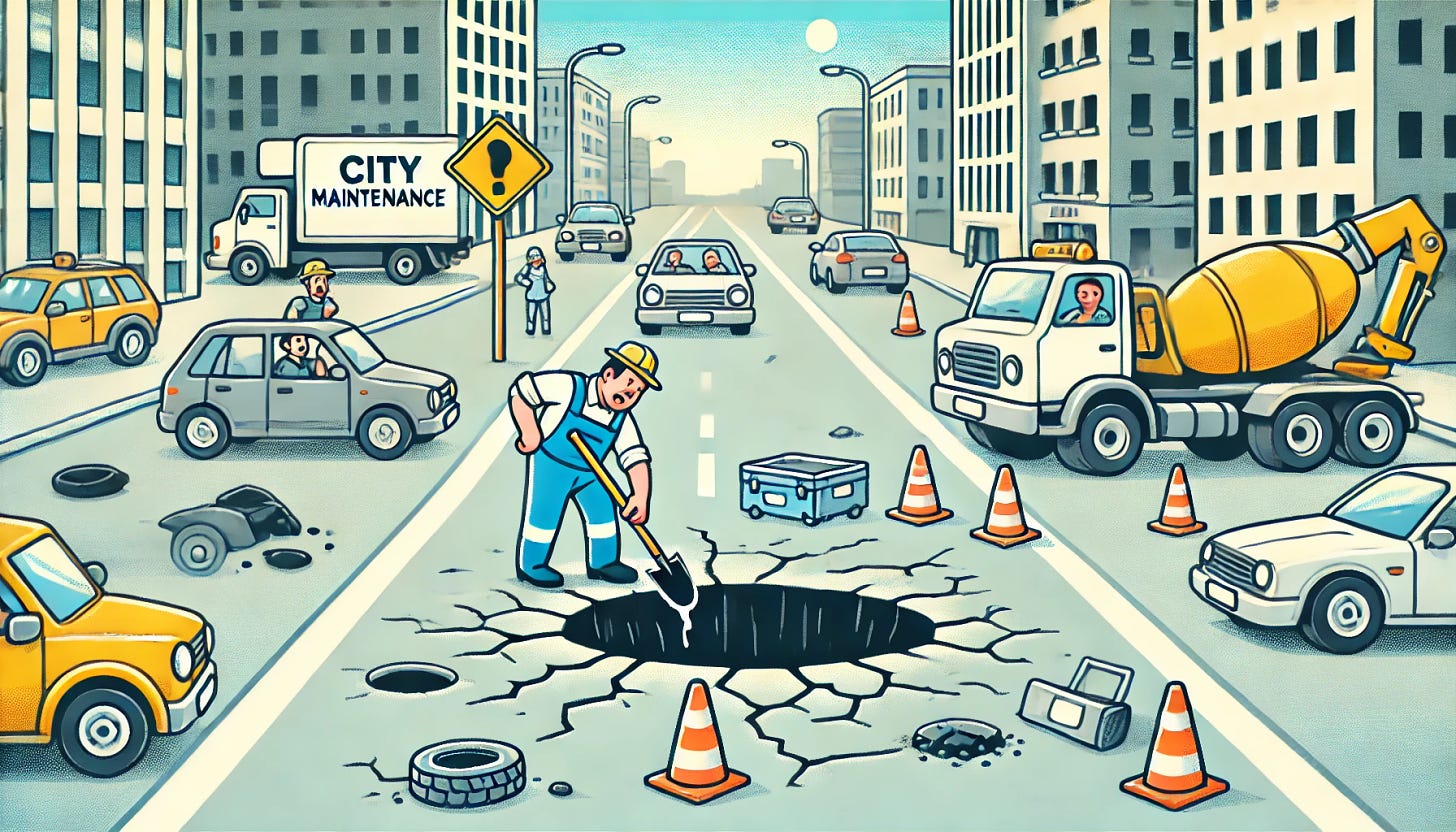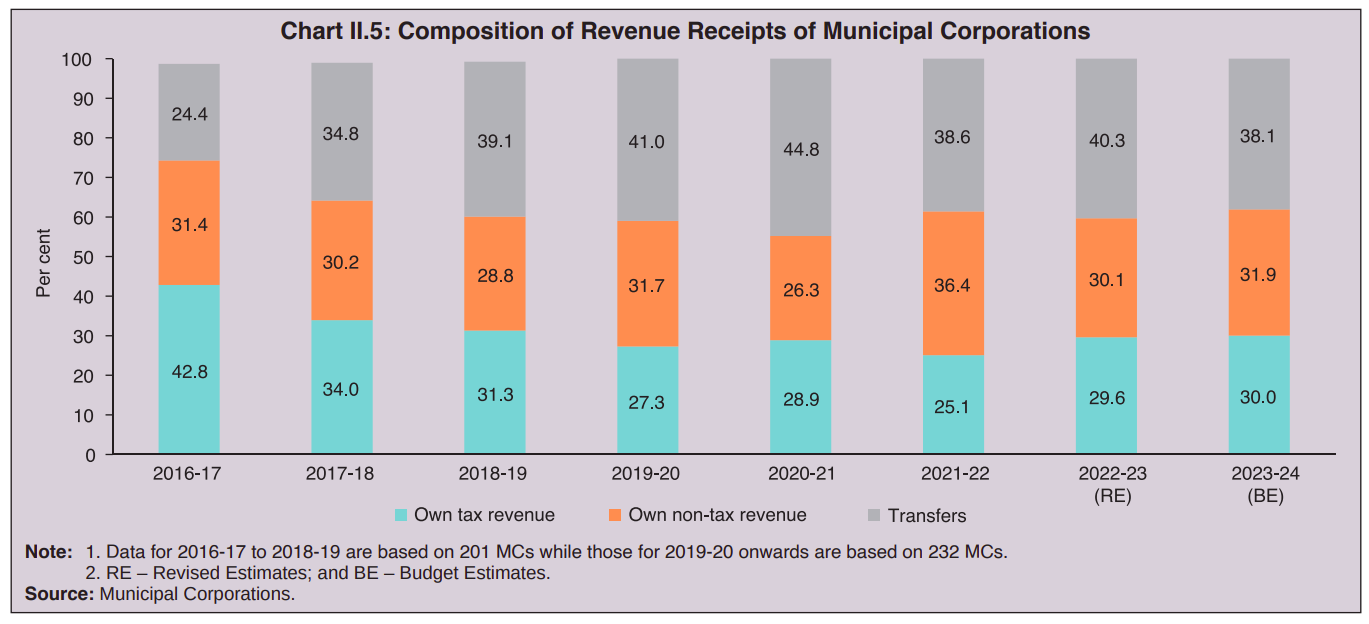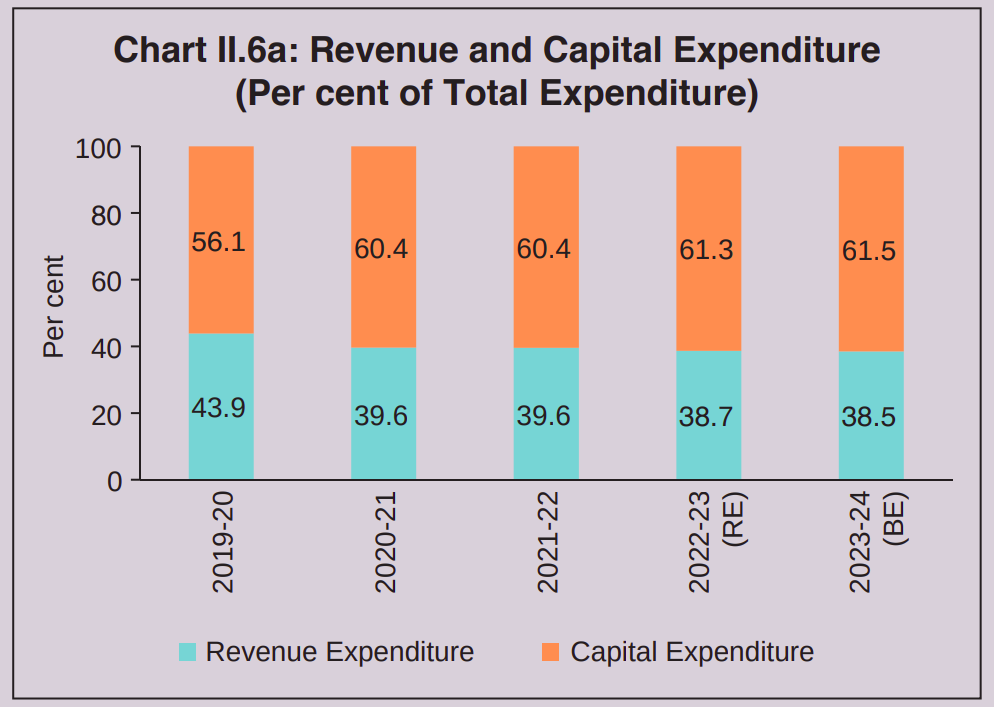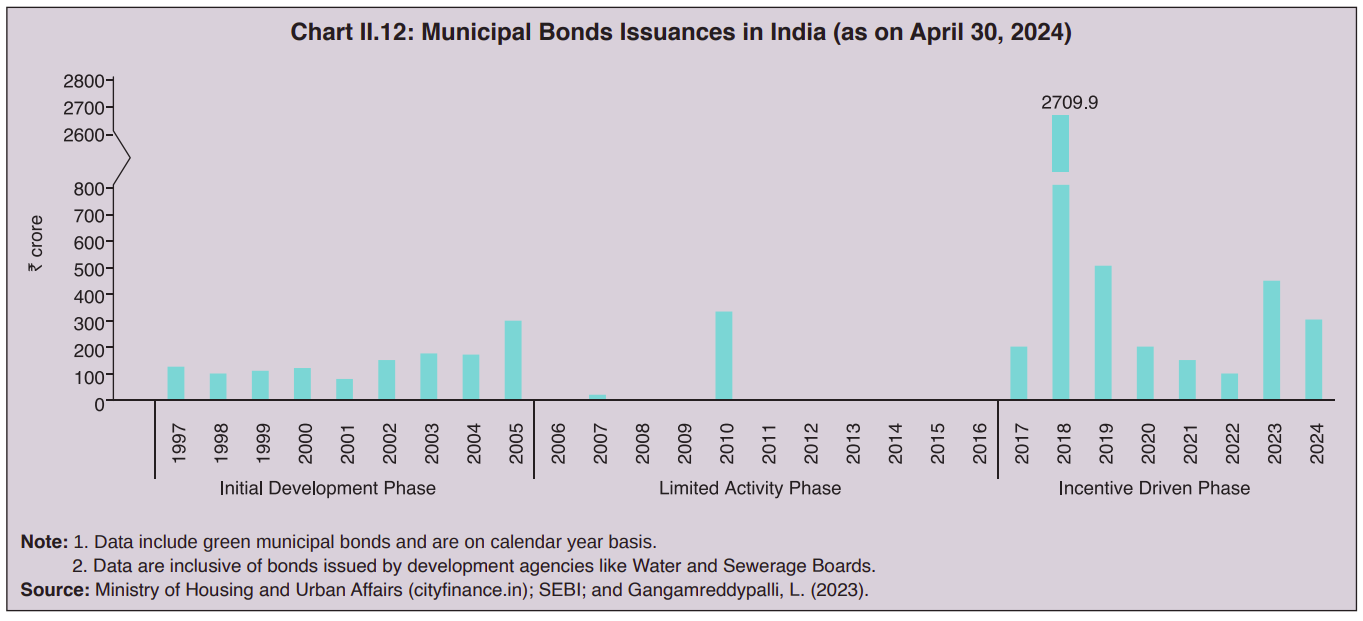Our goal with The Daily Brief is to simplify the biggest stories in the Indian markets and help you understand what they mean. We won’t just tell you what happened, but why and how too. We do this show in both formats: video and audio. This piece curates the stories that we talk about.
You can listen to the podcast on Spotify, Apple Podcasts, or wherever you get your podcasts and videos on YouTube. You can also watch The Daily Brief in Hindi.
Thanks for reading The Daily Brief by Zerodha! Subscribe for free to receive new posts and support my work.
In today’s edition of The Daily Brief:
- Who pays to fix your city?
- DOJ vs Google: Chrome’s Future at Stake
Who pays to fix your city?
Imagine this: you’re driving to work on an ordinary day when—BAM—you hit a pothole. Before you can catch your breath, you realize the road ahead is flooded, and to top it all off, there’s a massive traffic jam. Frustrated, you mutter a few curses at the city authorities. Aren’t they supposed to fix these problems?
But here’s the big question: why don’t things ever seem to get better? Is it just incompetence, or could there be something else going on? Maybe—just maybe—the municipality doesn’t have enough money to fix these issues in the first place.
Let’s break this down, starting with the basics.
City governments, or municipalities, are in charge of the everyday services we depend on—clean streets, working drains, garbage collection, safe parks, and yes, filling potholes. But as you can imagine, running a city isn’t cheap. Roads need constant repairs, drainage systems need upgrades, and streetlights need power. These are just a few of the bills municipalities need to cover.
And here’s the tricky part: most municipalities don’t have enough money to get all of this done. A recent report by the Reserve Bank of India (RBI) reveals that municipal finances in India are in serious trouble.
Urban areas contribute a massive 60% of India’s GDP, but here’s the shocker: all the municipal corporations across the country put together generate just 0.4% of the GDP as their own revenue. Yes, you read that right—only 0.4%.
And it gets worse. Even within that tiny slice, there’s a huge imbalance. The top 10 cities, like Mumbai and Delhi, make up over 58% of all municipal revenue, leaving smaller towns and lesser-known cities struggling to get by. So, if your city doesn’t have enough money, how can it possibly fix potholes or stop flooding? That’s likely the root of the problem.
Municipalities have two main ways of making money:
- Own Revenue: This is money they collect themselves through:
- Taxes: Property tax, water tax, electricity tax, and so on.
- Fees and Charges: Parking fees, garbage collection charges, fines, etc.
- Transfers: These are funds or grants given by state or central governments. Think of it like pocket money—it’s not earned but handed over by someone else.
Here’s where the issue lies: Indian municipalities are overly dependent on transfers. As of 2023-24, about 38.1% of municipal revenue came from transfers, while only 30% came from their own taxes. This dependency is growing. Back in 2016-17, municipalities earned 42.8% of their revenue from taxes, but that’s dropped to just 30%.
Source: RBI
Think of it like this—if your entire salary depended on your parents giving you money each month, you wouldn’t have much control over your finances, right? If they delayed or cut your allowance, you’d struggle to pay for rent or groceries. That’s exactly what happens to municipalities. When state or central governments delay grants, cities can’t cover even basic services like garbage collection or road repairs.
This dependency ties municipalities’ hands. They can’t plan or execute projects independently because they’re always waiting for someone else to approve the funds—and the timeline. It’s a cycle that keeps cities stuck in place.
Let’s take a closer look at how municipalities spend the money they have. Their expenses fall into two main categories:
- Revenue Expenditure: This covers everyday costs like paying salaries, keeping streetlights on, and collecting garbage.
- Capital Expenditure: This is for long-term projects, like building new roads, parks, or drainage systems.
Here’s something interesting: in recent years, capital expenditure has been growing much faster than revenue expenditure. In 2023-24, about 61.5% of municipal spending was expected to go toward big infrastructure projects, while only 38.5% was set aside for day-to-day maintenance. Compare this to 2019-20, when the split was more balanced—56.1% for capital expenditure and 43.9% for revenue expenditure.
Source: RBI
This shift shows that cities are putting more focus on flashy new projects, but they might be overlooking the basics. Sure, new roads and parks are exciting, but ignoring routine maintenance—like filling potholes or managing garbage—can make daily life frustrating for citizens.
So, here’s the real question: can municipalities find ways to raise more money?
Yes, they can. Some cities are already trying creative ways to boost their revenues. Take Bangalore, for instance. The city introduced a modern paid parking system in busy areas, adding ₹31.5 crore to its annual budget. Imagine the impact if other cities adopted similar ideas on a larger scale.
Another option is municipal bonds. These work like loans—cities borrow money from investors to fund big projects. Cities like Pune and Ahmedabad have even started issuing green bonds to fund eco-friendly initiatives. But here’s the catch: only financially stable cities with good credit ratings can access this option. Smaller municipalities, which are already struggling, often can’t take this route.
Source: RBI
If we want better services in our cities, municipalities need to focus on three key areas:
- Increase Own Revenue: This means collecting taxes more efficiently and coming up with innovative ways to charge for services. For example, digitizing property tax collection or offering online payment options can make it easier for people to pay and help reduce revenue leaks.
- Reduce Dependency on Transfers: By generating more of their own income, municipalities can become financially independent and avoid delays caused by waiting for funds from state or central governments.
- Balance Spending: While big projects like new roads and parks are important, municipalities must ensure they don’t neglect day-to-day maintenance like fixing potholes or keeping streets clean.
At the end of the day, better finances mean better services. If municipalities manage their money well, they’ll be able to fix roads, upgrade drainage systems, and make daily life better for all of us. As citizens, it’s in our interest to demand better financial management from our local governments.
After all, it’s our money, our city, and our quality of life on the line. So the next time you hit a pothole or wade through a flooded street, remember—better city finances could make all the difference.
DOJ vs Google: Chrome’s Future at Stake
Late last night, Bloomberg dropped some big news: the U.S. Department of Justice (DOJ) wants to force Google to sell Chrome, its hugely popular web browser. If that sounds extreme, it’s because it is. This isn’t just about breaking up a tech giant—it’s about untangling one of the most interconnected ecosystems in today’s digital world. Let’s break it down.
The DOJ is accusing Google of holding too much power over the internet through its search engine, advertising business, and other services. Earlier this year, federal judge Amit Mehta ruled that Google had illegally monopolized two key areas:
- Search Engines: Where we all go to find information online.
- Search Advertising: The ads that pop up when we search for something.
To keep its dominance, Google spends mind-blowing amounts of money—$20 billion a year—to make sure its search engine is the default choice on browsers like Apple’s Safari. For perspective, that’s more than NASA’s annual budget. Deals like these have made it nearly impossible for competitors to break into the market.
Now, the DOJ wants to level the playing field by forcing Google to sell Chrome and introducing changes to make the internet fairer for competitors. But here’s the catch: it’s not as simple as it sounds.
To understand why this is such a big deal, let’s look back at something similar: the breakup of AT&T in 1984. At the time, AT&T had a monopoly on telecommunications in the U.S. Breaking it up was relatively simple because AT&T owned physical assets—things like telephone lines and service centers. The government could divide the country into regions and assign each part to a new company.
Google, on the other hand, is a completely different story. Its empire isn’t built on physical assets; it’s built on data and algorithms. All its products—Chrome, Search, Android, and YouTube—are deeply interconnected. Here’s how it works:
- Chrome collects data on how people browse the internet.
- That data feeds into Google’s advertising algorithms , which power its entire business. Ads bring in 80% of Alphabet’s (Google’s parent company) revenue—about $300 billion last year.
- Those ads show up everywhere: on Google Search, YouTube, and millions of websites.
- Google’s AI uses the same data to improve search results and user experiences across its services.
If Chrome is separated from Google, it disrupts this entire ecosystem. It’s like trying to take the engine out of a car and expecting it to run smoothly. That’s what makes breaking up Google far more complicated than breaking up AT&T ever was.
The DOJ isn’t just focused on Chrome. They’re looking at a range of other measures, including:
- Sharing Search Data: Forcing Google to share its search data with competitors to help them build better alternatives.
- Separating Android: Splitting Android from Google’s other services, so phones running on Android wouldn’t automatically rely on Google apps like Maps or Gmail.
- Protecting Website Content: Giving websites more control over how their content is used in Google’s AI systems, so it isn’t exploited without permission.
- Restricting Data Use: Limiting how Google uses data across its services to reduce its dominance in every market it touches.
These changes aim to level the playing field, but they come with their own set of challenges. Google was designed to work as one tightly connected system. If you pull one piece away, the rest might struggle to function properly.
Google’s dominance isn’t just about having the biggest share of the market—it shapes how the internet works for all of us. For example:
- Chrome is the world’s most popular browser, holding 63% of the market. It’s how millions of people access everything online.
- Google Search handles over 90% of global searches, helping us find information, shop, and learn.
- Google’s business model—offering free services in exchange for user data—has defined how the internet operates today.
Breaking up Google could completely change this. Imagine an internet where services aren’t free anymore, or where ads are less personalized because companies don’t have access to as much data. It could reshape how we use technology and the internet in ways we can’t fully predict.
If Google is forced to sell Chrome, the big question is: who could buy it? This isn’t a small task. The buyer would need:
- Deep Pockets: Chrome is a massive platform with millions of users worldwide. Managing it requires significant resources.
- A Clean Record: The buyer can’t already be facing antitrust issues, which rules out companies like Microsoft or Amazon.
Some analysts have suggested that OpenAI, the company behind ChatGPT, could be a potential buyer of Chrome. With backing from Microsoft and expertise in AI, they could bring something new to the table. However, whoever takes over would face a big challenge. Without Google’s advertising revenue, Chrome would need to find a new way to make money while still keeping its quality intact.
This case isn’t just about business—it’s also about politics. Former President Trump recently expressed doubts about breaking up Google. He suggested focusing on making the company fairer, rather than dismantling it. This adds a layer of uncertainty to the situation, especially since the trial’s remedies phase won’t start until April 2025, after the next presidential election. A new administration could take a very different approach to regulating Big Tech.
The stakes are high. The DOJ’s actions could set a global precedent for how tech companies are regulated, not just in the U.S., but around the world. The European Union is already investigating Google, and the outcome of this case could influence how other countries deal with similar issues.
Meanwhile, Google isn’t staying silent. They’ve called the DOJ’s plan a “radical agenda” and argue that it could harm American innovation. They’re also adapting to new regulations, like finding ways to collect data without relying on third-party cookies, showing they can evolve even under pressure.
This case isn’t just about one company—it’s about the future of the internet. If the DOJ succeeds, we could see:
- More competition in search and advertising.
- New rules on how companies collect and use data.
- A shift in the “free services” model we’ve come to expect.
But we could also face some disruptions—services that don’t work as well, higher costs for users, and a less connected internet experience.
This case is more than just a legal battle. It’s a turning point for technology, business, and how we interact with the online world. Whether it leads to a fairer internet or unintended consequences is still unclear. One thing is for sure: this is a story that will continue to unfold for years to come.
Tidbits
- NTPC has announced plans to invest ₹5,00,000 crore in renewable energy by 2030, aiming for a total capacity of 60 GW, with 90% of it coming from solar power. Its subsidiary, NGEL, is gearing up for a ₹10,000 crore IPO to fund key projects, including a massive ₹56,000 crore, 7 GW hybrid solar-wind park in Gujarat.
- In the electric vehicle space, the government has advanced ₹3,000 crore in subsidies for over 1,20,000 electric three-wheelers after funds for FY24 ran out earlier than expected. While EV penetration has reached 22%, manufacturers are preparing for price hikes due to reduced subsidies.
- The Competition Commission of India (CCI) fined Meta ₹213 crore over its 2021 WhatsApp privacy policy, citing anti-competitive practices. Meta has been directed to revise its policies, aligning with global trends that emphasize user consent and control over data.
- Urban unemployment improved in Q2FY25, dropping to 6.4%. Female unemployment also saw progress, declining to 8.4%. The Labour Force Participation Rate increased to 50.4%, driven by more women entering the workforce and a shift towards jobs in manufacturing and services.
Thank you for reading. Do share this with your friends and make them as smart as you are ![]() Join the discussion on today’s edition here.
Join the discussion on today’s edition here.



